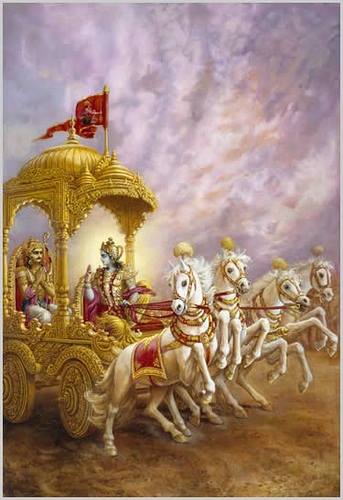Gita : Ch-6. Slo-29.
Srimad Bhagavad-Gita :
Chapter-6. ( Dyana-yogam )
Slokam-29. ( The state of 'Siddha-Purushan' is narreted by Sri Krishna here.....)
{ A true yogi observes Me in all beings, and also sees every being in Me. Indeed, the self-realized man sees Me everywhere.}
" Me = Lord ( Paramatma )."
sarvabhutasthamatmanam sarva-bhutani catmani,
ikshate yogayuktatma sarvatra samadarsanah.
yoga-yuktatma = the one 'yogi' who fix his cittam in atma;
sarvatra sama-darsanah = knowing that all completely brahma-mayam only;
atmanam sarva-bhuta-stham = of Paramatma in all things ( living and non-living );
sarva-bhutani atmani ca = and all entities in Paramatma;
ikshate = ( yogi ) sees.
Now Lord Krishna presents the four-fold divisions of the subsequent results of such a firmly established yogi or one perfected in the science of the individual consciousness attaining communion with the ultimate consciousness. Such a very advanced being has become united with the atma or soul thus perceiving the atma in all beings of multifarious, diverse natures and variegated physical and subtle bodies. This applies from the highest demigod known as Brahma down to an inanimate tree. How is it that such a yogi can perceive his atma existing in all beings and all beings existing in his atma. The words yoga-yuktatma meaning united with the nature of the Brahman or the spiritual substratum pervading all existence, one sees all things with equal vision, without any distinction between them knowing that all forms are veritable products of prakriti or material nature. The purport is such a yogi sees all forms, even his own as manifestation of the Brahman and therefore there is no distinctive difference in his atma and the atma of others. The atma is eternal and pure and distinctly different from the physical body. So firmly adhering to self-realisation such a yogi becomes enlightened in all respects. Yet even the physical bodies are equal as well as they all manifest from the same primordial matter and all have a beginning and an end. So in this way there is no contradiction if the yogi perceives his atma existing in all beings and all beings existing in his atma.
The words sarvatra sama-darsana means equal vision everywhere. This means realising the atma or soul that abides in oneself and abides in other beings is of the same transcendental essence in all beings equally. This is perceived by spiritual consciousness and this transcendental essence is an attribute equally present in all atma's. The equality, sameness and luminosity of the atma has been perceived by those recipients of moksa or liberation when the atma is divested of its connection with the physical body and material nature. Inequality as well as indifference and indolence arise from designating the atma as being non-different from the myriad of multifarious physical manifestations the atma is embodied by. The yogi or one perfecting the science of the individual consciousness with the ultimate consciousness, who mature in dhyana or meditation has achieved atma tattva or realisation of the soul, does not discern any differences in the myriad of multifarious physical manifestations but perceives the atma wherever it may reside in whatever physical or subtle body it manifests in. This is perceived by the atma's inherent and essential attribute of transcendental consciousness existing equally in all beings. Such is actual equal vision and one who perceives the atma abiding within oneself is of exactly the same essence, nature and quality as the atma perceived abiding in other beings realises that such beings are equal in this respect. The conclusion of what Lord Krishna is stating is that all atma's are eternal, from one eternal essence and that when one's own atma has been realised and perceived then every beings atma is realised and be perceived.
The necessity of realisation of the Brahman or the spiritual substratum pervading all existence is being given by Lord Krishna. The mature yogi whose mind is spiritually enlightened by the practice of yoga or the science of the individual consciousness attaining communion with the ultimate consciousness by dhyana or meditation. Who perceives the Brahman everywhere and who sees omniscience and omnipresence of the atma or soul without any limitations equally existing in all beings from the highest demigod to an inanimate tree. Such a person realises the Supreme Being existing within himself and himself existing within the Supreme Being.
The objective and goal to be gained is given here by Lord Krishna. The atma or eternal soul residing within all beings is the omnipresent and omniscient Supreme Lord. All creatures also exist within the Supreme Lord as the atma as well. One who perceives this sees the Supreme Lord equally in everything from a blade of grass to the Brahman or spiritual substratum pervading all existence. Therefore it has been said that one sees the Supreme Lord abiding in all creatures and all creatures abiding in the Supreme Lord.
The Supreme Lord abides in equal measure in all beings along with the atma or soul and is known as paramatma the Supreme Soul.
To be continued ...






Comments
Post a Comment